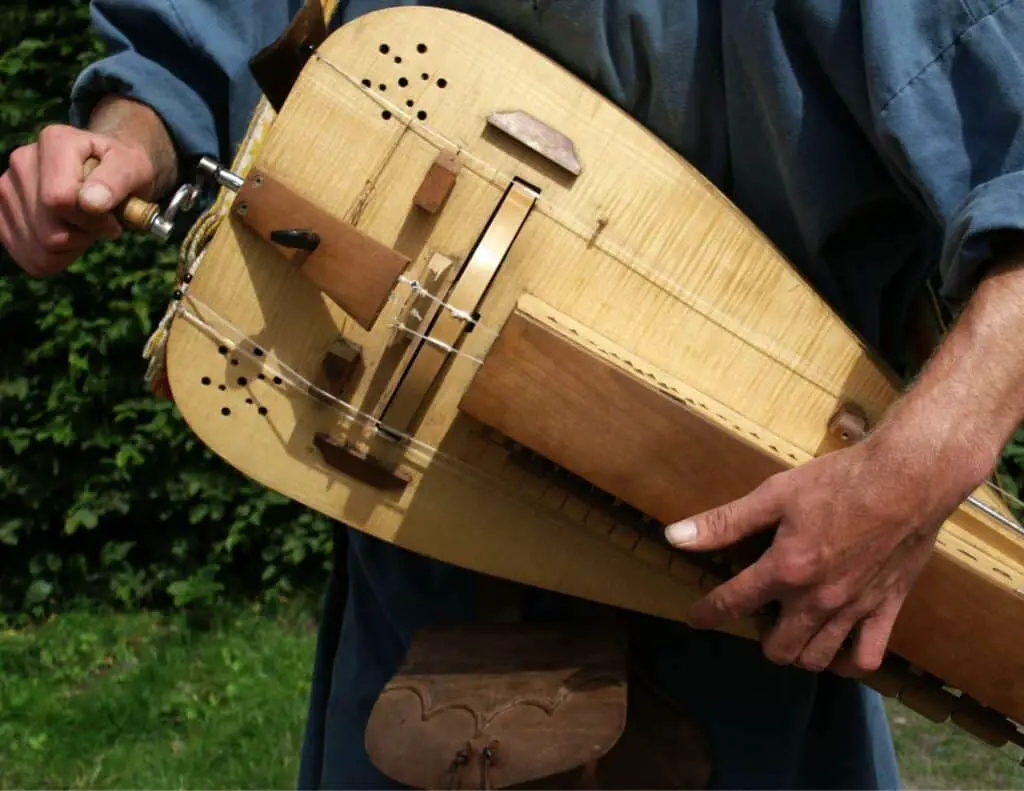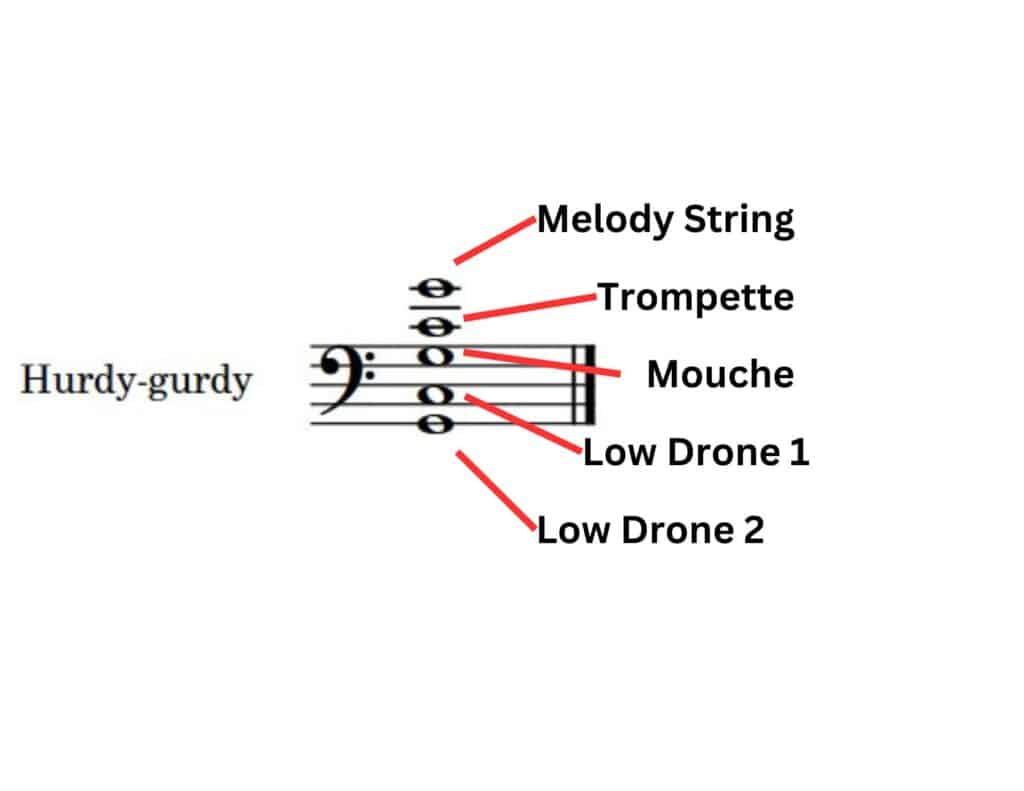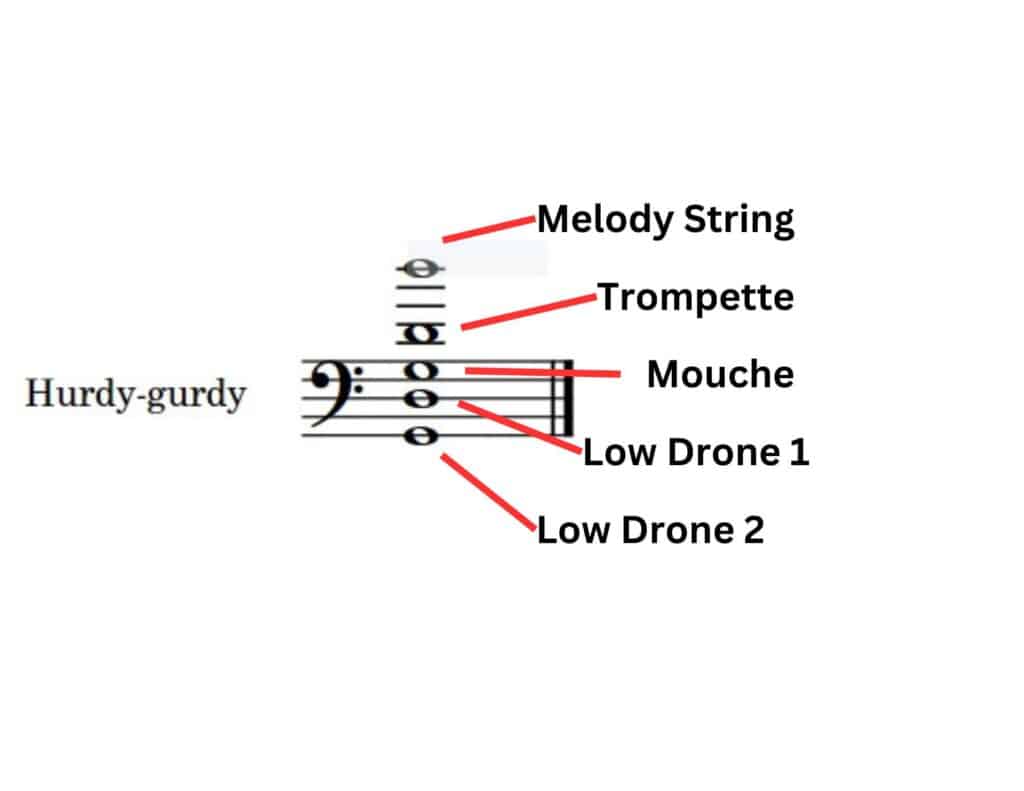
Step into the captivating world of the hurdy-gurdy and uncover the intricate mechanics that bring this unique instrument to life.
From its humble beginnings to the present day, the hurdy-gurdy has fascinated musicians and enthusiasts alike with its mesmerizing sounds and fascinating mechanism.
In this article, I’m going to dig into the inner workings of this extraordinary instrument, tracing how you go from turning a crank to the creation of beautiful melodies. Join me and let’s explore the mechanics of the hurdy-gurdy.
Key Takeaways
- The hurdy-gurdy is a string instrument that produces sound by a hand-crank-turned, rosined wheel rubbing against the strings.
- The anatomy of a hurdy-gurdy consists of a soundboard, a neck with keys that stop the strings, and two sets of strings: melody and drone.
- To play the hurdy-gurdy, the musician turns a crank that rotates the wheel and presses the keys on the neck to stop the melody strings and produce different notes.
Table of Contents
Mechanics of the Hurdy-Gurdy
The anatomy of a hurdy-gurdy consists of a soundboard, which amplifies the vibrations of the strings, and a neck, which supports the strings and has keys that stop the strings to produce different notes.
The instrument has two sets of strings: the melody strings, which are played by the keys, and the drone strings, which produce a constant sound and add depth to the melody.
To play the hurdy-gurdy, the musician turns a crank that rotates the wheel, which in turn vibrates the strings. The musician then presses the keys on the neck to stop the melody strings and produce different notes. The drone strings add a constant sound that complements the melody.
Wheel and Crank
The wheel and crank are the most distinctive parts of the hurdy gurdy. The wheel is similar to a violin bow and is made of wood or plastic. The crank is attached to the wheel and is used to turn the wheel. As the wheel turns, it rubs against the strings, producing a sound.
Strings
The strings on a hurdy gurdy are made of gut or metal. They are stretched over the instrument’s body and are attached to the pegbox at the top of the instrument. The strings are tuned by adjusting the tension using the tuning pegs.
Keyboard and Tangents
The keyboard and tangents are used to change the pitch of the strings. The keyboard is a set of wooden keys that are pressed down to change the length of the strings that are played. The tangents are small wooden blocks that press against the strings, shortening them and producing a higher pitch.
Soundboard and Resonance
The soundboard is the flat wooden surface on the front of the hurdy gurdy. It is usually made of spruce or cedar and is responsible for amplifying the sound produced by the strings. The hollow cavity inside the instrument also contributes to the resonance and amplification of sound. The buzzing bridge, which is a small wooden bridge that sits on the soundboard, also helps to produce the characteristic buzzing sound of the hurdy gurdy.

The Mechanics of Playing a Hurdy-Gurdy
Creating Sound
The hurdy-gurdy produces sound through the interaction of several components. The rosined wheel, which functions similarly to a violin bow, rubs against the strings. The crank turns the wheel, and as the wheel rotates, it causes the strings to vibrate. The vibration of the strings creates sound.
Playing Techniques
To play a hurdy-gurdy, the musician must press the melody strings against the diatonic keyboard, which replaces the fingerboard. The keyboard has a layout similar to that of a piano, with white and black keys. The musician can also use techniques such as vibrato, which involves pressing up and down on the keys repeatedly.
The Role of the Drone Strings
The drone strings on a hurdy-gurdy provide a continuous, low-pitched sound that serves as a foundation for the melody. The drone strings are arranged in groups of two or three and are typically tuned to the same pitch. They are located furthest away from the musician, with the melody strings closer to the player.
The Chien and Buzzing Bridge
The chien, also known as the dog, is a small wooden peg that rests against the melody strings. The musician can adjust the pressure of the chien on the strings to produce a buzzing sound. The buzzing sound is created by the string vibrating against the chien.
The buzzing bridge, located near the drone strings, also produces a buzzing sound when the musician rotates the crank.
C/G Tuning VS. D/G Tuning on the Hurdy-Gurdy?
Tuning a hurdy-gurdy to either C/G or D/G refers to the specific pitch arrangement of the strings on the instrument. The hurdy-gurdy is a unique and ancient stringed instrument that produces sound through a combination of strings, a rosined wheel, and keys. The tuning of the instrument determines the range and key in which it will primarily play.
The C/G tuning and D/G tuning are two common tunings used in the hurdy-gurdy world. Let’s take a closer look at each tuning:
C/G Tuning
In C/G tuning, the drone strings of the hurdy-gurdy are tuned to the pitches of C and G. The melody strings, which are played using the keyboard, are typically tuned diatonically within the key of C.
This tuning allows for easy playing in the key of C major or its relative minor, A minor. Many traditional and folk tunes are composed in these keys, making C/G tuning popular for playing traditional melodies. This tuning is also suitable for accompanying other instruments or singing in the key of C.

D/G Tuning
In D/G tuning, the drone strings are tuned to the pitches of D and G. The melody strings are usually tuned diatonically within the key of D. This tuning enables playing in D major or its relative minor, B minor, which is another common key in traditional music.
By using the keyboard, the musician can create different melodies while maintaining a drone in the key of D or G. This tuning is often favored in Celtic and Irish music due to its compatibility with traditional tunes in those genres.

Both C/G and D/G tunings offer their unique tonal characteristics and are suitable for different musical contexts. The choice of tuning depends on the style of music one wishes to play and personal preference.
It’s worth noting that these are just two of the many possible tunings for the hurdy-gurdy. Depending on the musical tradition or individual preference, other tunings such as Bb/F or Eb/Bb can be used as well. The hurdy-gurdy’s versatility allows players to explore various tunings and adapt to different musical requirements.
Learning to Play the Hurdy Gurdy
Learning to play the hurdy gurdy can be a challenging but rewarding experience. With its unique sound and medieval charm, this instrument has gained popularity in recent years. In this section, we will cover the basics of playing the hurdy gurdy, advanced techniques, and finding a teacher.
Understanding the Basics
The hurdy gurdy is a string instrument that produces sound by a hand-crank-turned, rosined wheel rubbing against the strings.
The wheel functions much like a violin bow, and single notes played on the instrument sound similar to those of a violin.
The strings are typically arranged in three groups: low-pitched drone strings, melody strings, and high-pitched drone strings. The melody strings feed into a keybox, which replaces a finger/fretboard and has the same chromatic key layout as a piano keyboard.
To play the hurdy gurdy, you need to turn the crank with one hand while pressing the keys with the other hand to change the pitch of the melody strings. The drone strings provide a constant background drone that adds to the unique sound of the instrument.
Advanced Techniques
One important technique is learning to control the trifecta of cotton/rosin/string pressure. This helps you produce a clear and consistent sound. You can also experiment with different rhythms and tempos to create a variety of musical styles.
Another advanced technique is learning to play chords on the hurdy gurdy. This involves pressing multiple keys at once to produce a harmonious sound. It takes time and practice to master this technique, but it can add depth and complexity to your playing.
Finding a Teacher
A good teacher can help you master the basics, learn advanced techniques, and provide feedback on your playing. They can also recommend workshops and other resources to help you improve your skills.
To find a teacher, you can search online for hurdy gurdy instructors in your area. You can also check with local music schools or community centers to see if they offer hurdy gurdy lessons. You can also find teachers through online resources like Michalina Malisz.
When choosing a teacher, look for someone who has experience playing and teaching the hurdy gurdy. You can also ask for recommendations from other musicians or hurdy gurdy players.
Frequently Asked Questions
What Is the History of The Hurdy Gurdy?
The hurdy gurdy is a stringed instrument that dates back to the Middle Ages. It is believed to have originated in Europe, and was commonly used by minstrels and troubadours. The instrument was also popular in folk music, and has been used in various forms of music throughout history.
What Are the Components of A Hurdy Gurdy?
The hurdy gurdy consists of several components, including a wheel, strings, keys, and a crank. The wheel is turned by the crank, and the strings are pressed against it by a bridge. The keys are used to change the pitch of the strings, and the buzzing sound is created by a device called a buzzing bridge.
How Is the Sound Produced in A Hurdy Gurdy?
The sound in a hurdy gurdy is produced by the wheel rubbing against the strings, much like a violin bow. The strings are pressed against the wheel by a bridge, and the pitch is changed by pressing the keys.
What Is the Playing Technique for A Hurdy Gurdy?
The playing technique for a hurdy gurdy involves turning the crank with one hand, while using the other hand to press the keys and adjust the pitch of the strings. The buzzing sound is created by pressing the buzzing bridge against the strings.
What are some popular songs played on the hurdy gurdy?
Some popular songs played on the hurdy gurdy include “La Folia,” “Saltarello,” and “Greensleeves.” The instrument has also been used in various forms of music, including folk, classical, and rock.
What Are Some Interesting Facts About the Hurdy Gurdy?
The hurdy gurdy was once considered a peasant instrument, but has since gained popularity among musicians and collectors. It has been used in various forms of music throughout history, and is still used today in traditional and modern music. The instrument has also been featured in several movies and television shows.
